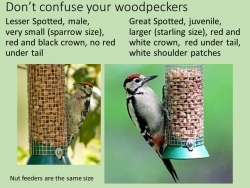Lesser Spotted Woodpeckers are feeding young.
As of 23 May, LesserSpotNetwork volunteers are monitoring 6 active nests with the first young due to fledge this week and the others over the next couple of weeks. So this the last chance to find a nest this year. If you found birds earlier in the season, please revisit the area and watch for adults bringing food to the young, they may lead you to find the nest.
A huge thank you to all our LesserSpotNetwork volunteers who have spent hundreds of hours in the woods searching for and watching these elusive birds.
In February and March, we had high hopes of a successful breeding season for Lesser Spots. We had more reports of birds calling, drumming, displaying and holding territories than in previous years. We thought this might be due to ‘lockdown’ with more people visiting their local woods when they could not travel to regular birding hot spots.
 3 Lesser Spot chicks in their nest on 21 May 2021In April volunteers had found over 30 possible breeding territories and at some both male and female birds were excavating nest cavities.
3 Lesser Spot chicks in their nest on 21 May 2021In April volunteers had found over 30 possible breeding territories and at some both male and female birds were excavating nest cavities.
But the weather in April was exceptionally cold, windy and dry which has adversely affected the food supply for woodland birds. Tree leaf opening is delayed by several weeks and as a result there are few defoliating and other caterpillars, their main food source. Many bird species have delayed or paused breeding this year including both Great Spotted and Lesser Spotted Woodpeckers.
 2 chicks from clutch of 5 eggs due to fledge in about a weekIn early May Lesser Spot Net volunteers were following 19 active nesting attempts.
2 chicks from clutch of 5 eggs due to fledge in about a weekIn early May Lesser Spot Net volunteers were following 19 active nesting attempts.
As of 23 May observers are monitoring 6 active nests with the first young due to fledge next week, see photo. We expect the others to fledge in the next 2 weeks.
But we have bad news from the other nesting attempts. Using our special nest inspection cameras, we have been able to view inside 6 more of the excavations. All 6 had full cavities lined with wood chips ready to receive eggs but have not been used. Another cavity has been taken over by Blue Tits.  Nest cavity lined with wood chips excavated in a dead Poplar tree by a pair of Lesser Spots but not usedThere is no activity reported from the other sites.
Nest cavity lined with wood chips excavated in a dead Poplar tree by a pair of Lesser Spots but not usedThere is no activity reported from the other sites.
We are hoping that, with sustained effort over the next two weeks, observers will find other nests when the young are being fed and the adult birds are more visible. But our hopes are fading.
The other important factor for breeding success is how many chicks are raised. Lesser Spotted Woodpeckers normally lay a clutch of 5-7 eggs but from the two nests observed so far the brood size has already reduced to 3 and 2 chicks respectively. This is bad news. Our work through LesserSpotNetwork has already shown that the failure to fledge enough chicks is a big problem. More details here
Note: We are not revealing the locations of the active nests at this stage. Similarly we are not naming our volunteer observers here to prevent them being put under any pressure at this sensitive stage of the breeding season.




